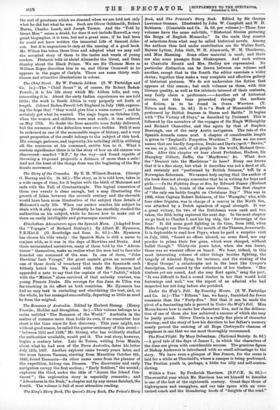The King's Story Book, The Queen's Story Book, The Prince's
Story
Book, and The Princess's Story Book. Edited by Sir George Lawrence Gomme. Illustrated by John W. Campbell and W. H. Robinson. (Constable and Co. as. 6d. per volume.)—These four volumes have the same sub-title, " Historical Stories picturing the Reign of English Monarchs." In the main they consist of selections from what may be called historical novels. Among the authors thus laid under contribution are Sir Walter Scott, Bulwer Lytton, John Galt, W. H. Ainsworth, W. M. Thackeray, and Miss Manning Some other material is used ; and there are also some passages from Shakespeare. And such writers as Charlotte Bronto and Mrs. Shelley are represented. No particular distinction can be drawn between one volume and another, except that in the fourth the editor exercises a wider choice; together they make a very complete and effective gallery of historical pictures. We do not undervalue the fiction that appears at this season ; but such volumes as these, with this literary quality, as well as the intrinsic interest of their contents, may fairly claim a preference.—Another set of historical stories, not this time presented through the medium of fiction, is to be found in Ocean Warriors. (T. Nelson and Sons. 2s. 6d.) It is "a Book of Memorable Deeds performed by British Seamen in Storm and Battle." It begins with "The Victory off Sluys," as described by Froissart. This is followed by the narrative of the voyages of Sir Hugh Willoughby and Richard Chancellor, and this again by that of Stephen Burrough, one of the early Arctic navigators. The tale of the Spanish Armada comes next. A chapter of considerable length is given to "England's Forgotten Worthies." Here we see some names that are hardly forgotten, Drake and Davis (spelt " Davies," we see, on p. 124), and, of all people in the world, Richard Gren- ville. After this chapter we hear about Frobisher, Hudson, Sir Humpbry Gilbert, Baffin, the ' Mayflower,' &c. What does the "Descent into the Maelstrom" do here? Every one knows that it is a fine story, but what it describes was not a deed at all, and certainly not "performed by British Seamen," left by a Norwegian fisherman. We cannot help saying that the author of the book does not always remember that he is writing for boys and girls.—In the Fighting Days at Sea, by Edward Fraser (Herbert and Daniel. 5s.), treats of the same theme. The first chapter of "the only sea battle fought on Christmas Day." This was in 1666, when Captain Robert Robinson, of the Warspite,' who, with four other frigates, was in charge of a convoy in the North Sea, was attacked by a Dutch squadron of equal strength. It was a great victory, for two of the Dutchmen were sunk and two taken, the fifth being captured the next day. In the next chapter we go back to Charles I. and his big ship, the ' Sovereign of the Seas.' It did some good fighting in its time, from 1652, when Blake fought van Tromp off the mouth of the Thames, downwards. It is deplorable to read how Pepys, when he paid a surprise visit in July, 1663, "found no officer aboard, no arms fixed, nor any powder to prime their few guns, which were charged, without bullet though." Thirty-six years later, when she was burnt, there was no warrant officer on board. We hear, indeed, in this most interesting volume of other things besides fighting, the tragedy of Admiral Byng, for instance, and the sinking of the Royal George,' a catastrophe not in the least like Cowper's description, but caused by the rottenness of her timbers. " Her timbers yet are sound, And she may float again," sang the poet. "It was difficult to find a sound timber in her that would hold fastenings and nail," was the report of an admiral who had inspected her not long before she perished.


































































 Previous page
Previous page